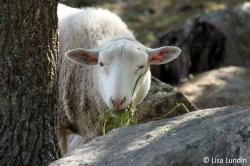Background

Zoo visitors are a large part of the zoo setting and even though opening hours and visitor density may vary, many zoo animals experience groups of visitors daily. Visitors might watch the animals passively but they might also try to interact with the animals which could include a range of actions that could be more or less stressful for the animals, such as pointing, staring, shouting, knocking on glass etc. This leads to a conflict that is often present in zoos; providing opportunities for paying visitors to see exotic animals up close, and providing the animals with environments that ensure their well-being.
Previous research indicates that zoo visitors in at least some cases are stressful to zoo animals. Visitor presence, density and intensity have been seen to affect several behaviors in zoo animals such as affiliative, agonistic and stereotypic behaviors, as well as have an effect on physiological measures such as cortisol levels. If the stress is prolonged it can have negative impacts health and well-being of the animals, and therefore also their welfare.
My studies were conducted at Parken Zoo, located in Eskilstuna, Sweden. In this project, there are two separate studies within the field of visitor effects as Parken Zoo wanted studies conducted on two different parts of the zoo. The first study involves the zoo’s drills (Mandrillus leucophaeus) and the second study the free roaming animals in the park’s petting zoo: alpacas (Vicugna pacos), sheep (Ovis aries) and goats (Capra hircus).
Aim

The aim of this study was to investigate how zoo visitors affect the behavior of the drills and petting zoo animals at Parken Zoo, Eskilstuna, and if these visitor effects have any welfare implications for the animals.
Responsible for this page:
Director of undergraduate studies Biology
Last updated:
05/09/13
